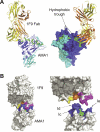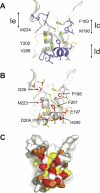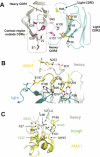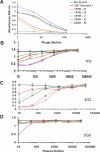Structure of the malaria antigen AMA1 in complex with a growth-inhibitory antibody
- PMID: 17907804
- PMCID: PMC2323298
- DOI: 10.1371/journal.ppat.0030138
Structure of the malaria antigen AMA1 in complex with a growth-inhibitory antibody
Erratum in
- PLoS Pathog. 2007 Nov;3(11):e172
Abstract
Identifying functionally critical regions of the malaria antigen AMA1 (apical membrane antigen 1) is necessary to understand the significance of the polymorphisms within this antigen for vaccine development. The crystal structure of AMA1 in complex with the Fab fragment of inhibitory monoclonal antibody 1F9 reveals that 1F9 binds to the AMA1 solvent-exposed hydrophobic trough, confirming its importance. 1F9 uses the heavy and light chain complementarity-determining regions (CDRs) to wrap around the polymorphic loops adjacent to the trough, but uses a ridge of framework residues to bind to the hydrophobic trough. The resulting 1F9-AMA1-combined buried surface of 2,470 A(2) is considerably larger than previously reported Fab-antigen interfaces. Mutations of polymorphic AMA1 residues within the 1F9 epitope disrupt 1F9 binding and dramatically reduce the binding of affinity-purified human antibodies. Moreover, 1F9 binding to AMA1 is competed by naturally acquired human antibodies, confirming that the 1F9 epitope is a frequent target of immunological attack.
Conflict of interest statement
Figures






Similar articles
-
Antibodies to polymorphic invasion-inhibitory and non-Inhibitory epitopes of Plasmodium falciparum apical membrane antigen 1 in human malaria.PLoS One. 2013 Jul 5;8(7):e68304. doi: 10.1371/journal.pone.0068304. Print 2013. PLoS One. 2013. PMID: 23861883 Free PMC article.
-
Overcoming antigenic diversity by enhancing the immunogenicity of conserved epitopes on the malaria vaccine candidate apical membrane antigen-1.PLoS Pathog. 2013;9(12):e1003840. doi: 10.1371/journal.ppat.1003840. Epub 2013 Dec 26. PLoS Pathog. 2013. PMID: 24385910 Free PMC article.
-
The most polymorphic residue on Plasmodium falciparum apical membrane antigen 1 determines binding of an invasion-inhibitory antibody.Infect Immun. 2006 May;74(5):2628-36. doi: 10.1128/IAI.74.5.2628-2636.2006. Infect Immun. 2006. PMID: 16622199 Free PMC article.
-
Apical membrane antigen 1: a malaria vaccine candidate in review.Trends Parasitol. 2008 Feb;24(2):74-84. doi: 10.1016/j.pt.2007.12.002. Epub 2008 Jan 15. Trends Parasitol. 2008. PMID: 18226584 Review.
-
Apical membrane antigen 1 as an anti-malarial drug target.Curr Top Med Chem. 2011;11(16):2039-47. doi: 10.2174/156802611796575885. Curr Top Med Chem. 2011. PMID: 21619512 Review.
Cited by
-
Population genetic structure and natural selection of Plasmodium falciparum apical membrane antigen-1 in Myanmar isolates.Malar J. 2018 Feb 7;17(1):71. doi: 10.1186/s12936-018-2215-7. Malar J. 2018. PMID: 29415731 Free PMC article.
-
Diverse Roles of TgMIC1/4/6 in the Toxoplasma Infection.Front Microbiol. 2021 Jun 17;12:666506. doi: 10.3389/fmicb.2021.666506. eCollection 2021. Front Microbiol. 2021. PMID: 34220751 Free PMC article. Review.
-
Structural and immunological characterization of an epitope within the PAN motif of ectodomain I in Babesia bovis apical membrane antigen 1 for vaccine development.PeerJ. 2021 Jul 16;9:e11765. doi: 10.7717/peerj.11765. eCollection 2021. PeerJ. 2021. PMID: 34316404 Free PMC article.
-
Characterization of a novel inhibitory human monoclonal antibody directed against Plasmodium falciparum Apical Membrane Antigen 1.Sci Rep. 2016 Dec 21;6:39462. doi: 10.1038/srep39462. Sci Rep. 2016. PMID: 28000709 Free PMC article.
-
A broadly cross-reactive i-body to AMA1 potently inhibits blood and liver stages of Plasmodium parasites.Nat Commun. 2024 Aug 22;15(1):7206. doi: 10.1038/s41467-024-50770-7. Nat Commun. 2024. PMID: 39174515 Free PMC article.
References
-
- Breman JG, Alilio MS, Mills A. Conquering the intolerable burden of malaria: What's new, what's needed: a summary. Am J Trop Med Hyg. 2004;71:1–15. - PubMed
-
- Sachs J, Malaney P. The economic and social burden of malaria. Nature. 2002;415:680–685. - PubMed
-
- Baird JK. Host age as a determinant of naturally acquired immunity to Plasmodium falciparum. Parasitol Today. 1995;11:105–111. - PubMed
-
- Cohen S, McGregor IA, Carrington SC. Gamma-globulin and acquired immunity to human malaria. Nature. 1961;192:733–737. - PubMed
-
- Cohen S, Butcher GA. Properties of protective malarial antibody. Nature. 1970;225:732–734. - PubMed
Publication types
MeSH terms
Substances
Associated data
- Actions
- Actions
Grants and funding
LinkOut - more resources
Full Text Sources
Other Literature Sources
Molecular Biology Databases

